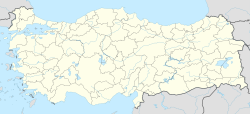Our website is made possible by displaying online advertisements to our visitors.
Please consider supporting us by disabling your ad blocker.
Alalakh
Alalaḫ | |
 Archaeological site of Alalakh (Tell Açana) | |
| Alternative name | Tell Atchana |
|---|---|
| Location | Hatay Province, Turkey |
| Region | Levant |
| Coordinates | 36°14′16″N 36°23′05″E / 36.23778°N 36.38472°E |
| Type | Settlement |
| History | |
| Founded | c. 2200 BC |
| Abandoned | c. 600 BC |
| Site notes | |
| Excavation dates | 1937–1939, 1946–1949, 2003-2004 |
| Condition | In ruins |
Alalakh (Tell Atchana; Hittite: Alalaḫ) is an ancient archaeological site approximately 20 kilometres (12 mi) northeast of Antakya (historic Antioch) in what is now Turkey's Hatay Province. It flourished as an urban settlement in the Middle and Late Bronze Age, c. 2000-1200 BC.[1] The city contained palaces, temples, private houses and fortifications. The remains of Alalakh have formed an extensive mound covering around 22 hectares.[2] In the Late Bronze Age, Alalakh was the capital of the local kingdom of Mukiš.[3]
The first palace was built around 2000 BC, and likely destroyed in the 12th century BC. The site was thought to have never been reoccupied after that, but archaeologist Timothy Harrison showed, in a (2022) lecture's graphic, it was inhabited also in Amuq Phases N-O, Iron Age, c. 1200-600 BC.[4]
- ^ Ingman, Tara, et al., (2021). "Human mobility at Tell Atchana (Alalakh), Hatay, Turkey during the 2nd millennium BC: Integration of isotopic and genomic evidence", in PLoS ONE 16(6), June 30, 2021, p. 2.
- ^ Riehl, Simone, (2022). "Late Bronze Age Tell Atchana", Tubingen University.
- ^ Yener, K. Aslıhan, (2007). "The Anatolian Middle Bronze Age kingdoms and Alalakh: Mukish, Kanesh and trade", Anatolian Studies 57, pp. 151−160.
- ^ Harrison, Timothy, Lynn Welton, and Stanley Klassen, (13 July 2022). "Highway to Science: The Tayinat and CRANE Projects", ARWA Association, Lecture min. 6:58, [in the graphic]: "Iron Age, Ca. 1200-600 BCE, Amuq Phases N-O...Primary Site: Tell Tayinat, Other Excavated Sites: Tell Atchana..."
Previous Page Next Page



